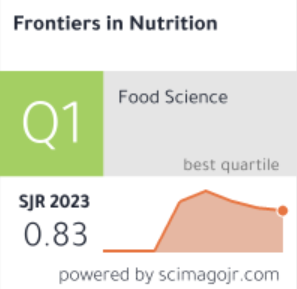摘要
简介成人营养不良是一种常见但未被诊断的疾病,而肥胖症在这一人群中非常普遍。骨肌肉疏松症是肌肉疏松症和骨质疏松/骨质疏松症的并存,与较高的发病率和死亡率有关。营养不良已被确定为骨质疏松症的相关因素之一,但营养不良的风险是否也与骨质疏松症有关,目前尚不清楚。另一方面,肥胖也与骨质疏松症有关,并且已确定肌肉、骨骼和脂肪之间关系的几种生物机制。然而,在这两种情况下,都缺乏纵向研究来评估这些情况是否会先于骨肉疏松症并增加其风险。因此,本研究旨在评估 50 岁及以上居住在墨西哥社区的成年人中营养不良风险和肥胖与骨肉疏松症之间的关联:这是一项来自 FraDySMex 队列的二次纵向研究。我们将 2014 年和 2015 年的数据作为基线评估,将 2019 年的数据作为后续评估。营养不良风险通过 "迷你营养评估 "进行评估,肥胖根据 DXA 测量的体脂百分比进行评估,骨肉疏松症根据 FNIH 标准进行诊断。为了评估肥胖与营养不良风险之间的关系,我们估计了混合效应逻辑回归模型。最终模型对性别、年龄、合并症、教育程度、体育锻炼和认知障碍进行了调整:本研究共纳入了 304 名参与者,对他们进行了两次评估(基线和随访)。参与者的基线平均年龄为 69.6 岁(标准差 9.1),年龄从 50 岁到 92 岁不等。大多数参与者为女性(83.2%),40%的人受过 7 至 12 年的教育,近一半的人在基线评估时被归类为久坐不动(47.8%)。营养不良风险和肥胖都会增加骨肉疏松症的风险,OR值分别为2.24(95% CI:1.20-4.19)和2.22(95% CI:1.17-4.23):我们的研究结果表明,在社区居住的 50 岁及以上成年人中,营养不良风险和肥胖风险可能会先于骨肉疏松症并增加其风险。Introduction: Undernutrition risk in adults is a common but undiagnosed condition, while obesity is highly prevalent in this population. Osteosarcopenia is the coexistence of sarcopenia and osteopenia/osteoporosis and is related to higher morbidity and mortality. Undernutrition has been identified as an associated factor of osteosarcopenia; however, it is unknown whether undernutrition risk is also related to this condition. On the other hand, obesity has been associated with osteosarcopenia, and several biological mechanisms in the relationship between muscle, bone, and fat have been identified. However, in both cases, there is a lack of longitudinal studies that allow evaluation of whether these conditions precede and increase the risk of osteosarcopenia. Therefore, the objective was to evaluate the association between undernutrition risk and obesity with osteosarcopenia among Mexican community-dwelling adults aged 50 and over.
Methods: This is a secondary longitudinal study from the FraDySMex cohort. We considered data from 2014 and 2015 as baseline evaluations and 2019 as the follow-up evaluation. Undernutrition risk was assessed using the Mini Nutritional Assessment, obesity was assessed based on body fat percentage measured by DXA, and osteosarcopenia was diagnosed according to the FNIH criteria. To evaluate the association of obesity and undernutrition risk, we estimated mixed-effects logistic regression models. The final model was adjusted for sex, age, comorbidity, education, physical activity, and cognitive impairment.
Results: A total of 304 participants with two evaluations (baseline and follow-up) were included in the study. The baseline mean age of participants was 69.6 years (SD 9.1), with ages ranging from 50 to 92 years. Most of the participants were female (83.2%), 40% had between 7 and 12 years of education, and almost half were categorized as sedentary (47.8%) at baseline evaluation. Both undernutrition risk and obesity increased the risk of osteosarcopenia, with an OR of 2.24 (95% CI: 1.20-4.19) and an OR of 2.22 (95% CI: 1.17-4.23), respectively.
Conclusion: Our findings suggest that undernutrition risk, on the one hand, and obesity, on the other hand, can precede and increase the risk of osteosarcopenia in community-dwelling adults aged 50 and over.

 求助内容:
求助内容: 应助结果提醒方式:
应助结果提醒方式:


